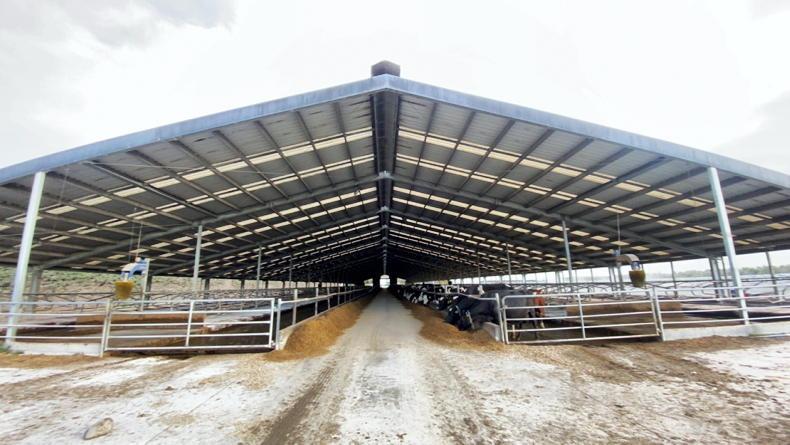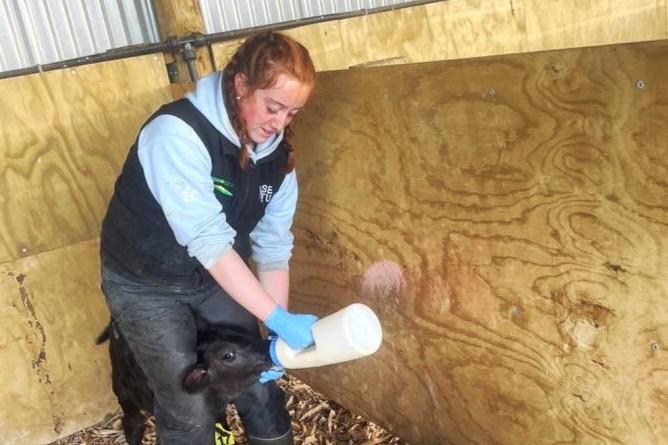"I am from a dairy farm in West Cork. I have just started back into third year, studying BSc in agriculture at the South East Technology University (SETU) Waterford.
"Growing up on a farm and being exposed to the multiple aspects of farming life, including milking, animal husbandry, nutrition, and so on, certainly influenced my decision to study agriculture.
Gaining practical experience
“The course is run in partnership with SETU Waterford and Kildalton Agricultural College, and provides excellent opportunities to expand my knowledge and learn other sides of farming that I wouldn’t be familiar with.
“The balance between theory and practical is great, as you get to work with the animals and machinery, while having the guidance of the lecturers to get the best learning outcome. The opportunity to go abroad was a big factor in choosing this course, so I was delighted to head to New Zealand last January.
“The farm I was working on, Kolmar Dairies in the Canterbury region, was a great example of all that is exceptional about dairy farming in New Zealand. Kolmar is a big enterprise – an all-rounder.
The big numbers meant I got to experience the quick-paced, hands-on system used, and I had to quickly get up to speed
“It currently milks 1,600 cows, mainly Holstein Friesians along with a number of Montbéliardes, in an 80-bale rotary parlour. This was a new experience for me, as we operate a herringbone at home. Kolmar calves four times a year on a 500ha farm.
“The cows were divided into four different herds, based on their productivity and due dates for calving. They rotate between being housed morning and night in the barn, which is a conjoined shed consisting of 350 cubicles each side.
“A typical morning for me would start at 4am and we would finish milking and washing up at 10.30am. We then started milking again at 1.30pm and finish around 6pm.
"There were always two people milking and working, as a tram made it very efficient. Another member of staff would cover in for an hour at 6am, so each person could get half an hour for breakfast.
Farm structure in New Zealand

Barn in New Zealand.
“The farm uses AI for all cows. It synchronises the heifers and then runs a bull for any repeats. The breed of calves is either Friesians or Wagyu, with the odd one being a Speckle Park.
“The big numbers meant I got to experience the quick-paced, hands-on system used, and I had to quickly get up to speed. Kolmar has an excellent training and mentorship ethos and the senior workers were always willing to guide me – so the magnitude of the jobs became less daunting.
“There are similarities to home in the way they operate, but the main difference in
farming between Ireland and New Zealand would be the scale, their calving system and irrigation requirements. The newborn calves stay with the mother typically for just a few hours, unless it was an overnight calving – then they are collected the following morning and brought from the paddock into the calf pens.
“Unlike Ireland, New Zealand doesn’t get huge amounts of rain, meaning they have to run an irrigation system, such as motorised pivots, where the water is collected from on-site lagoons.
Use of back-fence
“Working in New Zealand has been one of the best experiences. The opportunity to work and live in a different culture, and the friends I made, will stand to me forever. One take home, which I think would benefit farmers in Ireland, would be the use of the back-fence.
"Although paddocks wouldn’t compare in size to New Zealand, the use of a back-fence would help reduce land being poached or overgrazed in the harsh weather conditions we face at home.
“I am delighted to be pursuing a career in agriculture. For any young person thinking of doing agriculture at third level, I would recommend it.
"The opportunities and experiences you can gain from this industry are huge, whether it is the practical side of farming or the more theoretical side. It’s also great to see increasing numbers of women in all areas of agriculture.”
"I am from a dairy farm in West Cork. I have just started back into third year, studying BSc in agriculture at the South East Technology University (SETU) Waterford.
"Growing up on a farm and being exposed to the multiple aspects of farming life, including milking, animal husbandry, nutrition, and so on, certainly influenced my decision to study agriculture.
Gaining practical experience
“The course is run in partnership with SETU Waterford and Kildalton Agricultural College, and provides excellent opportunities to expand my knowledge and learn other sides of farming that I wouldn’t be familiar with.
“The balance between theory and practical is great, as you get to work with the animals and machinery, while having the guidance of the lecturers to get the best learning outcome. The opportunity to go abroad was a big factor in choosing this course, so I was delighted to head to New Zealand last January.
“The farm I was working on, Kolmar Dairies in the Canterbury region, was a great example of all that is exceptional about dairy farming in New Zealand. Kolmar is a big enterprise – an all-rounder.
The big numbers meant I got to experience the quick-paced, hands-on system used, and I had to quickly get up to speed
“It currently milks 1,600 cows, mainly Holstein Friesians along with a number of Montbéliardes, in an 80-bale rotary parlour. This was a new experience for me, as we operate a herringbone at home. Kolmar calves four times a year on a 500ha farm.
“The cows were divided into four different herds, based on their productivity and due dates for calving. They rotate between being housed morning and night in the barn, which is a conjoined shed consisting of 350 cubicles each side.
“A typical morning for me would start at 4am and we would finish milking and washing up at 10.30am. We then started milking again at 1.30pm and finish around 6pm.
"There were always two people milking and working, as a tram made it very efficient. Another member of staff would cover in for an hour at 6am, so each person could get half an hour for breakfast.
Farm structure in New Zealand

Barn in New Zealand.
“The farm uses AI for all cows. It synchronises the heifers and then runs a bull for any repeats. The breed of calves is either Friesians or Wagyu, with the odd one being a Speckle Park.
“The big numbers meant I got to experience the quick-paced, hands-on system used, and I had to quickly get up to speed. Kolmar has an excellent training and mentorship ethos and the senior workers were always willing to guide me – so the magnitude of the jobs became less daunting.
“There are similarities to home in the way they operate, but the main difference in
farming between Ireland and New Zealand would be the scale, their calving system and irrigation requirements. The newborn calves stay with the mother typically for just a few hours, unless it was an overnight calving – then they are collected the following morning and brought from the paddock into the calf pens.
“Unlike Ireland, New Zealand doesn’t get huge amounts of rain, meaning they have to run an irrigation system, such as motorised pivots, where the water is collected from on-site lagoons.
Use of back-fence
“Working in New Zealand has been one of the best experiences. The opportunity to work and live in a different culture, and the friends I made, will stand to me forever. One take home, which I think would benefit farmers in Ireland, would be the use of the back-fence.
"Although paddocks wouldn’t compare in size to New Zealand, the use of a back-fence would help reduce land being poached or overgrazed in the harsh weather conditions we face at home.
“I am delighted to be pursuing a career in agriculture. For any young person thinking of doing agriculture at third level, I would recommend it.
"The opportunities and experiences you can gain from this industry are huge, whether it is the practical side of farming or the more theoretical side. It’s also great to see increasing numbers of women in all areas of agriculture.”







 This is a subscriber-only article
This is a subscriber-only article










SHARING OPTIONS: